720 Search Results for model
January 27, 2014
by Robin Parker -
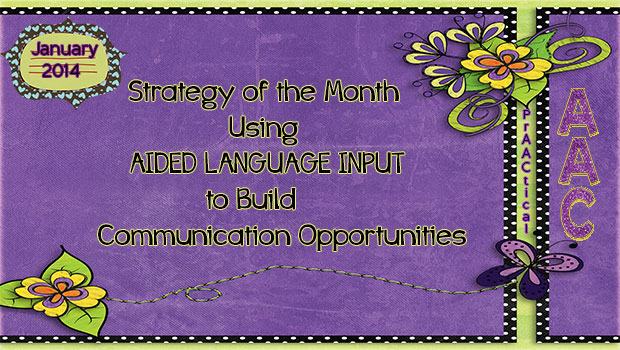
We can not write, speak or do enough Aided Language Input (ALI). If we expect learners to speak AAC, we must speak AAC to them. It is difficult enough to learn a language and imagine if no one spoke it to you in the language you were expected to speak…But there are so many more reasons to do ALI. Aided Language Input (ALI) belongs in the context of communication opportunities. It is modeling AAC style. Once we model a target language concept AAC style, then add the wait and signal strategy, the learner then knows it is their communicative turn. Especially if you wait with the raised eye brow signal. They often will take their turn expressively. But, if they do not take the communicative opportunity to take their turn, there are gestural, visual, verbal, and physical prompts that can be implemented. In other words, they can make use of... [Read More...]
January 23, 2014
by Carole Zangari -
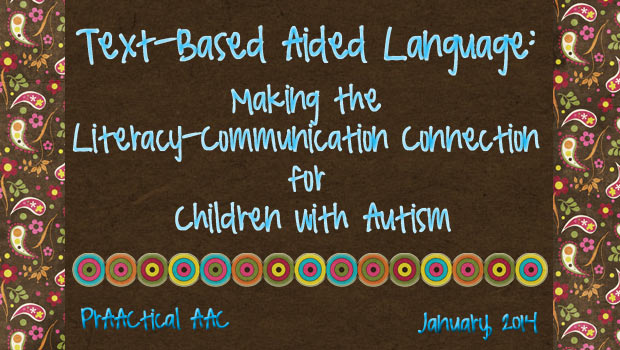
We are so pleased to have this guest post by Alicia Garcia. She is the lead SLP at AAC Clinic at One Kids Place, in Ontario. You can read her previous post here. Today, Alicia takes us in a textual direction. Enjoy! When working with children with autism who have complex communication needs we have found it is not uncommon to see children who, despite having significant communication and language challenges, can read and sometimes type words. Their ability to decode written words is far superior to their ability to communicate their wants, needs and thoughts. Some of these children use AAC systems for their face-to-face communication and, in some cases, have a literacy program in place; they frequently have handy access to writing or typing tools. These children do not, however, use text to communicate with people. They have not made the Literacy-Communication connection. We wonder… how do we help these... [Read More...]
January 13, 2014
by Robin Parker -
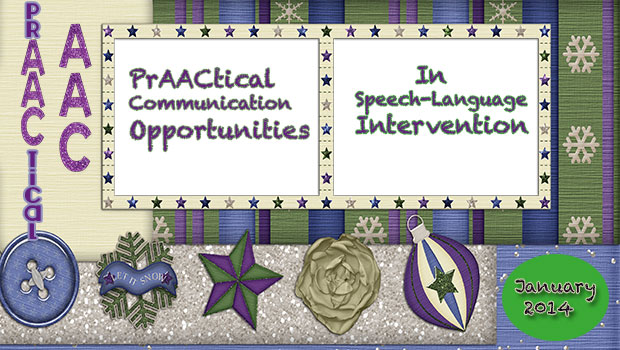
Planning for communication opportunities in every aspect of speech-language therapy helps ensure productive use of time and effort for both clinician and learner. It is not enough to talk to a student, it is not enough to provide fun activities without lots of opportunity for active participation and more specifically communication initiation. Another word for communication initiation/opportunities is communication temptations. Communication temptations are structured situations designed to entice a variety of specific communication functions or semantic relations (Wetherby, 1988). There needs to be lots of times where there is targeted modeling and then a specific, obvious reason for the learner to be the initiator of communication. A temptation to communicate. Take a look at this sample therapy session for frequent and multiple communication opportunities. Please let us know a favorite or creative communication opportunity that you use. PrAACtical Considerations Meaningful AAC Goals– All quality speech-language intervention sessions start with meaningful... [Read More...]
January 2, 2014
by Carole Zangari -
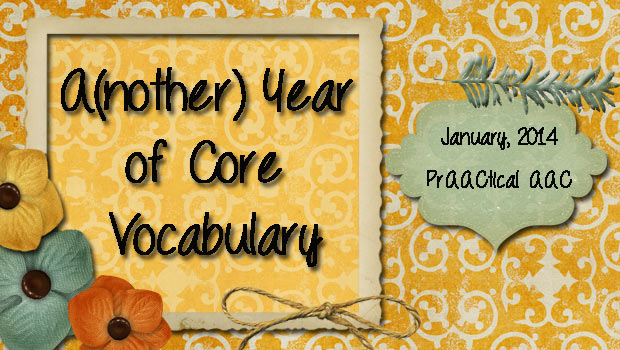
It hardly seems possible that a year has gone by since we posted a Year of Core Words 2013. We’ve been so gratified by the feedback from professionals and parents who’ve put it to good use and followed month-by-month to focus on a dozen core words and get suggestions for additional practice. We were thrilled when others added symbols, created teaching materials, and adapted it for their own use. Today we’re back with the 2nd Year of Core Words, this time with 16 words/month. If you follow along, you’ll have covered 192 new core words by the end. Once again, we created 12 grids of core vocabulary words – one for each month of the year. Each grid has 16 cells labeled with core words. Plug in the AAC symbols that your client uses (e.g., PCS, SmartySymbols, Unity, Pixons, etc.), print, laminate, and keep them handy. Feel free to adapt... [Read More...]
December 31, 2013
by Robin Parker -
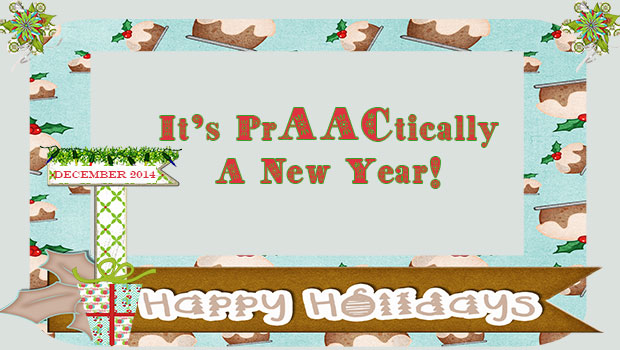
It is just about 2014. Hard to believe another year is finished and we are moving on once again. Our wishes for 2014 are for ALL Learners to have access to: Aided Language Input Communication Displays that meet their needs Role Models Presumed Competence Core Word Instruction Fringe Word Instruction Friends Many Meaningful Language Experiences Frequent Communication Opportunities Fun Learning Our Wishes for ALL SLP’s and Educators to have access to: An Exciting and Stimulating Personal Learning Network (PLN) Appropriate Goals and Strategies Meaningful Language Experiences Role Models Laminator and Laminator Materials Literacy Materials Core Word Highlighter Tools, Page Fluffers & Spacers, Apps for Learning Language An AAC Philosophy Fun Teaching
December 28, 2013
by Carole Zangari -
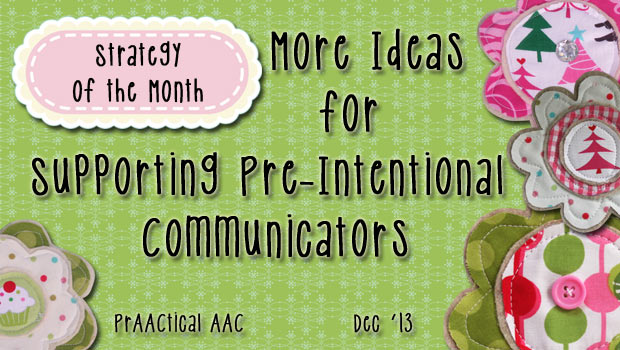
This month, we’ve been talking about how to support individuals who are at the earliest levels of communication: the perlocutionary or pre-intentional stage. Although everyone goes through a stage at which behavior is considered communicative only because the partner perceives it that way, some individuals linger there for months or years. What steps can SLPs take in order to help these children and adults have meaningful interactions and build more effective communication skills? Here are some prAACtical thoughts on the matter. Prepare for Skepticism Some people in the client’s life may not believe that there is real potential for communication growth. This is particularly true for learners who are a bit older. When children reach the late elementary school and are still at the pre-intentional stage, there is a tendency to fear that ‘real’ communication is beyond the learner’s grasp. In our view, that is rarely the case. VERY rarely.... [Read More...]
December 24, 2013
by Robin Parker -

Use social narratives to explain happy upcoming events, stressful upcoming events, and out of the routine type events. Not only do social narratives help with understanding, but they can also help with ways to talk about activities and events. Use Aided Language Input (ALI) to model. It will show that even when there is a lot going on, AAC is still important and a high priority. Give out some AAC related presents to educators, professionals, families, and AAC users. Create the visual supports for holiday songs and poems. Or use a single step or sequential message device to record the songs, so everyone can sing together. You can even program the songs into high tech devices and have quite the good singing voice. Provide frequent communication opportunities for the AAC user to make choices, give opinions, rate activities and events, vent, ask questions, tell, and share information. Make talking photo... [Read More...]
December 20, 2013
by Carole Zangari -
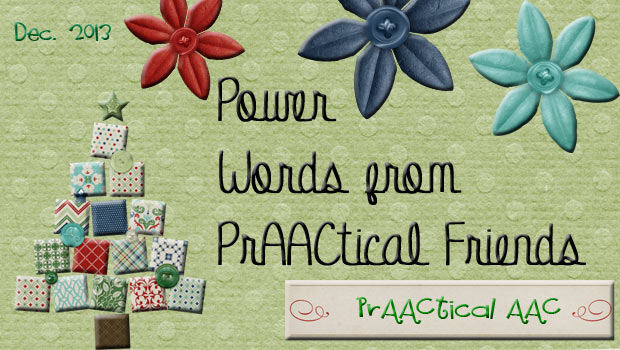
Teaching core vocabulary is the best way to pack a lot of power into an AAC system. As some of you know, we post things to the PrAACtical AAC Facebook Page a few times/day. Recently, we shared a link to a core word board from the I Can Newsletter folks that was posted on Boardmaker Achieve. We asked for suggestions for what you could say with those words. Here’s are some great ideas from our prAACtical friends: Come again: Love that this can be used in a literal sense, but also as a snarky comment Get help Go away: Language learning and self-advocacy – this one’s a two-fer! Your bad Stop it. Ready, go! Go get it. I like it. I want all done! I want more You do/did it. You stop it. You want it. What you want? We’ll take any opportunity to model questions and teach how to... [Read More...]
December 13, 2013
by Carole Zangari -
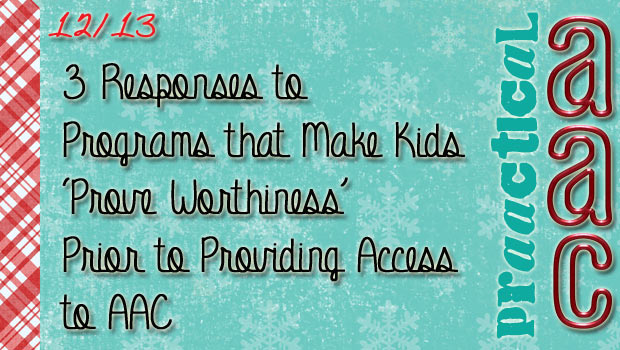
Like many of you, we continue to hear about programs that withhold AAC supports from children who are nonverbal or minimally verbal. Sometimes they point to the perceived lack of readiness that the child has for AAC, in general. Other times, they erect barriers, such as an artificial benchmark that insists that children start with no-tech AAC (e.g., communication boards, books, PECS) or low tech SGDs before ‘earning the right’ to sophisticated AAC options. As yet another year comes to a close, it is hard to believe that there are still programs, administrators, or, worse yet, our SLP colleagues who think they are truly justified in limiting access to AAC. How can we move beyond tearing our hair out, drinking excessively, or ranting to our friends? Here are some ideas. “Show me the evidence.” Ask for empirical support for the position that withholding access to AAC tools and strategies is more... [Read More...]
December 12, 2013
by Robin Parker -
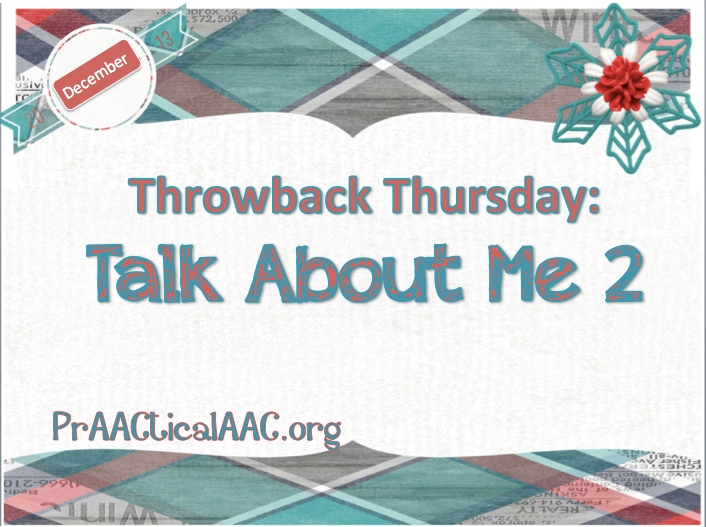
originally published December 13, 2012 We write about a lot of AAC strategies and we often give examples of different types of learners. Sometimes the learners we work with have more challenges than we explain. Lest you think, we do not see the really ‘challenging’ learners, we do, we really do. For those individuals with more challenges than most, sometime we are asked, well what do a few visual supports or AAC strategies do? What difference do they make? The truthful answer is A LOT. Here are a just a few recent examples from some really amazing families. When a mom is on the phone, a young adult brings in a timer and sets it so mom will get off the phone and go sit with her. When a communication book is forgotten on an emergency trip to the dentist, drawing on a napkin is enough to keep everyone calm... [Read More...]









